A new paper looks at marsquakes and what is causing them, which turns out to be magma moving. And Curiosity has found rocks it needs to go around. Then there is the weather on Mars. Plus, lunar formation, a giant comet, and this week in rocket history, we look back at Apollo 13.
Podcast
Show Notes
Moon impact made Man in the Moon (maybe)
- Brown University press release
- “A South Pole–Aitken impact origin of the lunar compositional asymmetry,” Matt J. Jones et al., 2022 April 8, Science Advances
That giant comet? It’s not exactly headed our way
- Hubblesite press release
- UCLA press release
- “Hubble Space Telescope Detection of the Nucleus of Comet C/2014 UN271 (Bernardinelli–Bernstein),” Man-To Hui (許文韜), David Jewitt, Liang-Liang Yu (余亮亮), and Max J. Mutchler, 2022 April 12, The Astrophysical Journal Letters
Ingenuity completes 25th flight
- Making Tracks to the Delta (NASA)
Weijia Sun & Hrvoje Tkalčić document repetitive marsquakes
- “Repetitive marsquakes in Martian upper mantle,” Weijia Sun & Hrvoje Tkalčić, 2022 March 30, Nature Communications
Curiosity explores Mount Sharp
- NASA press release
Weather update: It snowed on Mars
- Mars’s Dust Cycle Controls Its Polar Vortex and Snowfall (Eos)
- “Dust-Driven Polar Vortex Dynamics and Snowfall From Mars Climate Sounder Observations,” N. R. Alsaeed, P. O. Hayne, and V. Concepcion, 2022, 53rd Lunar and Planetary Science Conference
This Week in Rocket History: Apollo 13
- Apollo 13 Mission (LPI via Internet Archive)
- PDF: Evaluation of a Pilot Describing Function Method Applied to the Manual Control Analysis of a Large Flexible Booster (NASA Technical Note)
- For Jack Swigert, On His 83rd Birthday (AmericaSpace)
- PDF: “Houston, we’ve got a problem.” (NASA)
Transcript
Today, we have tornadoes – not as science – but Pamela’s studio is having some bad weather, so pardon the booms and flashes.
We also have science: volcanoes on Mars, comets near Saturn, and a healthy dose of marsquakes.
And rockets and rovers and more.
All of this now, right here on the Daily Space.
I am your host Dr. Pamela Gay.
I am your host Erik Madaus.
And we’re here to put science in your brain.
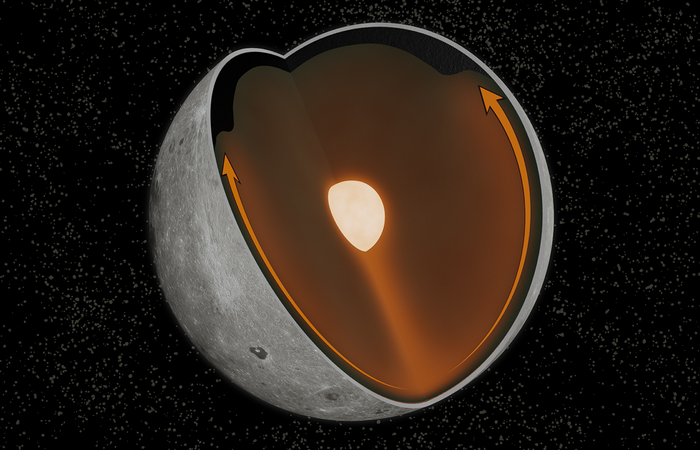
When we look at the two sides of the Moon, they look so different as to appear to be different worlds. The near side is a mix of light regolith and vast seas of dark mare that people often see as the “Man in the Moon”. The far side – the side we don’t get to see as the Moon goes around and never shows us its back – that far side is just craters next to craters, all in the lighter colored material.
How the Moon ended up this way is a matter of debate. The Moon’s high-density core is off-center, which is also weird. To try and piece all this weirdness together, we have to look at the history of our Earth-Moon system.
Once upon a time, in the early days, a Mars-sized object hit what was trying to become Earth. In the collision, both worlds were destroyed, and a bunch of their lighter crust materials splashed away while the two higher density cores merged together to create our planet Earth. As the lighter material orbited the Earth, it somehow eventually ended up in a single Moon, but it may have done this in two steps, with the bulk of the Moon coming together and then getting hit by a smaller pocket of leftover material that we now see as the Moon’s far side. This gives us a layer of material to make the Moon’s core appear off-center, and it may explain the difference in appearance, but the details don’t all just come together, and when scientists see inelegant data, they often go looking for a better solution.
And that better solution may have just been published.
In a new paper in Science Advances that is led by Matt Jones, researchers describe simulations of the impact that created the Moon’s south pole’s Aiken Basin. This is the second-largest crater in the solar system, and when the Moon was struck, the energy of the impact was transformed into heat, and that heat, the models say, traveled through the Moon. With the heat, there was melting and the movement of material through the lunar interior. Another way of saying that is the asteroid impact created magma – the stuff of volcanoes – and it flowed through the Moon carrying the specific chemistry of material we see in the lunar lava fields.
As Jones says: How the [chemistry of the lava] formed is arguably the most significant open question in lunar science. And the South Pole–Aitken impact is one of the most significant events in lunar history. This work brings those two things together, and I think our results are really exciting.
I have to say I think this is exciting, too, and I love how impacts are both digging down deep and building up the surface of the Moon in different ways.

This week there has been a new round of headlines that basically boil down to “NASA DISCOVERS GIANT COMET HEADED TOWARD EARTH.”
I feel the need to break this story down, make sure everyone knows we’re safe, and give you the info you need to join us in laughing at some of the more sensationalistic stories hitting the internet.
Here is what is true. There is a big ol’ hunk of mostly ice, some rock, and bits of organic material that are entering the main part of the solar system. This comet, C/2014 UN 271 Bernardinelli-Bernstein, or Bern-Bern, is about 80-85 miles across, which, for a comet, is huge — record-breakingly huge. It is also darker than coal, so think dirty snow from a polluted city.
Since we live in the main part of the solar system, and the comet is headed toward the main part of the solar system, it is fair to say it is headed toward us… in the same way that when someone from Asia visits greater St. Louis I can say they visited me. Did I see them? Nope. Was there really any chance I’d see them without getting in a car to take a drive? Nope. They just were a whole lot closer than normal.
This comet — it’s only getting about as close as Saturn. Saturn will still be closer though. So the only way we’re going to visit this comet is if we hop in a rocket and fly to it.
So, bottom line, the comet is big. No argument. Giant awesome comet. It is going to be close enough to the Sun – while out at Saturn – that it should get active. You should be excited, just not as excited as some headlines would lead you to think you should be.
As we get more data we’ll keep you updated.
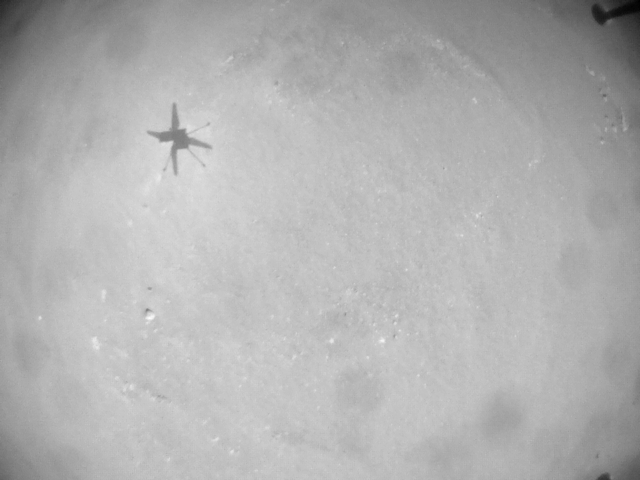
We’ll have a full segment on Mars right after this, but first an update on the Ingenuity Mars helicopter. On April 8, it completed its 25th flight over the Martian surface, traveling 704 meters in just under three minutes at a maximum speed of 5.5 meters per second, another speed record for the helicopter.
Ingenuity is continuing its operational mission extension, scouting ahead of the Perseverance rover to help mission planners decide which of two possible ways to traverse up to the delta at the mouth of Jezero Crater.
The rover is, for a rover, booking it over the crater’s surface, traveling over 300 meters in one day about 50 sols ago. It has traveled 6.6 kilometers since landing. It can only travel at 60 meters per hour (1/10th mph), a snail’s pace, but thanks to Ingenuity and the relatively flat terrain plus some other factors, it doesn’t have to stop as often and keeps driving day by day.
And now, we’re going to take a look at some more Mars science stories.
I have to admit, while everyone around here has been “rover this, rover that”, the Mars mission I was most excited about was Insight. It was supposed to burrow a temperature sensor several meters into the ground and deploy a seismograph that would finally answer the question, “Is Mars geologically active?” Geologically active means the world isn’t solid all the way through and is still capable of changing its surface and atmosphere through events ranging from outgassing to volcanism to marsquakes.

While that thermal sensor learned the giant sand trap that is Insight’s resting place on Mars is not good to try and dig in, the seismograph has been returning remarkable data, and in a new paper in Nature Communications, researchers document that Mars is indeed alive.
The two authors of this paper have names that make me really wish people put pronunciation guides on their web pages. We have their names written out on our website and for those of you watching us on tv or YouTube, the names are written below.
In their research, they document 47 new marsquakes that are in the same region as two earlier, high-quality events beneath Cerberus Fossae. This region contains fissures that run alongside each other marking where the crust is pulling apart.
These quakes occurred at all times of day and aren’t caused by tidal effects. The best fit for these shakes is the movement of magma in the upper mantle. According to the paper: The continuous seismicity suggests that Cerberus Fossae is seismically highly active and that the Martian mantle is mobile.
It’s impossible to know if this magma will ever ooze out to the Martian surface or if it will simply keep shaking things up. No matter what happens, this seems to indicate that Mars, or at least the part under Cerberus Fossae, is still very much alive.
And now back to rovers.

NASA’s Mars Curiosity rover is steadily advancing up its target Mount Sharp. Currently, it is on the Greenheugh Pediment, a large flat area made of sandstone. Near the pediment is an area called the Gediz Vallis Ridge where there is debris from further up the mountain. The debris is quite large – boulder-sized – so it must have been transported by water, making it worth studying.
Scientists wanted to study them up close by driving along the pediment to take pictures of the ridge. However, the rover is going to need to find a new route up the mountain because of a hazard. Ventifacts are rocks that have been eroded by wind action, and this type of rock has caused damage to Curiosity’s wheels before. The Curiosity team calls these rock formations “gator-back rocks” because they look like scales.
The engineers would like to avoid more damage to the wheels, so over the next few weeks, the rover will climb back down the mountain and resume exploring an area with clay minerals and sulfates, more signs of past water action.
As we deploy rovers and landers across Mars’s surface and fill its orbit with satellites, we are slowly being able to explore the hard questions, like how do we predict weather on a world where it snows carbon dioxide.
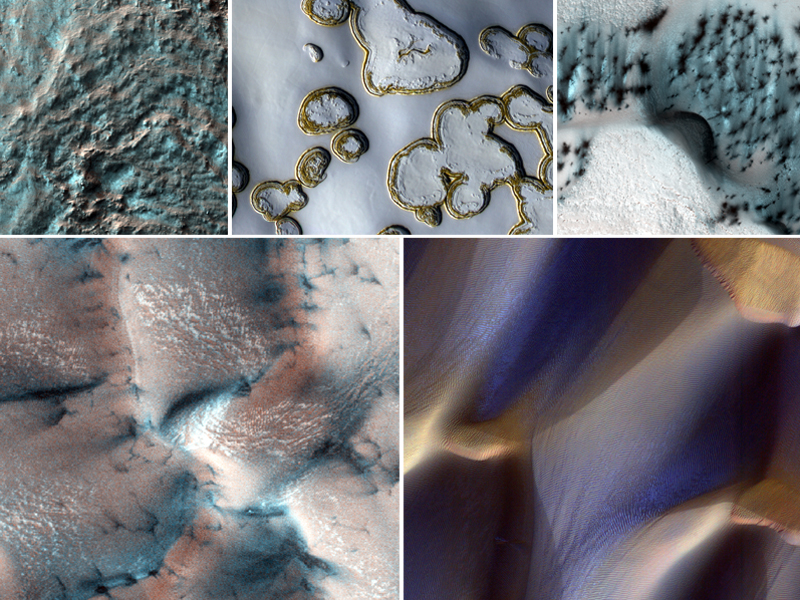
In a presentation at March’s Lunar and Planetary Science Conference by Noora Alsaeed, researchers document how dust plays a major role in Mars weather. This work is now summed up by Kimberly Cartier on EOS.org. With stunning imagery, this research documents how the movement of dust, instead of moisture, regulates Mars’ weather patterns. For instance, and I quote: Stronger southern dust cycles on Mars stifle its northern polar vortex and increase its snowfall rate, up to a point at least.
Using ten years of infrared data to track dust, Alsaeed looked at the dust seasons on Mars and how they correlated with the fall of carbon dioxide snow. It turns out that more dust is good for more snow. Alsaeed explains: The Mars dust cycle is very important, and the poles are very important in terms of regulating heat and atmospheric circulation. The fact that they’re so tightly coupled makes sense in a way, but it’s really important to understand just how that coupling works. This work highlights just how tightly coupled they are, and I hope that more work in the future looks at what the direct line of influence is.
Folks, go check out the imagery used in the story Cartier wrote. It is stunning. We’ll link to it on our website, DailySpace.org.
And while you go looking, we’re going to look back on rocket history.
This Week in Rocket History
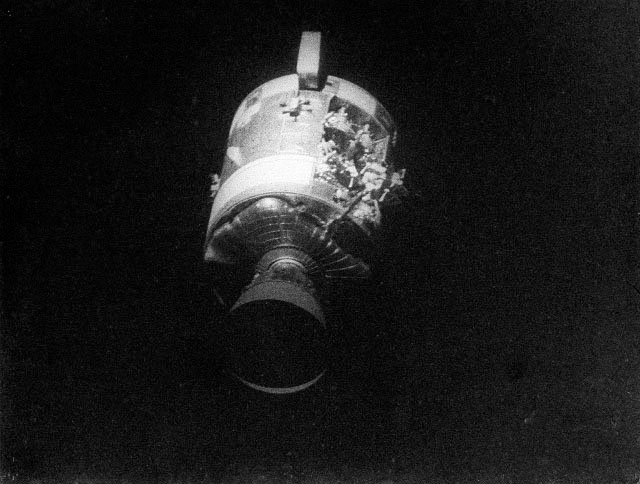
This Week in Rocket History is also about fuel cells: Apollo 13. This is one of the few missions I think most people have heard about, even if they aren’t space enthusiasts. However, there are some questions you may have and interesting things about the mission that you might not know, so This Week in Rocket History will be all about those.
But first a short summary. Apollo 13 launched on April 13, 1970. Three days into the mission one of the liquid oxygen tanks for the fuel cells exploded during a routine maintenance task due to frayed wiring causing a spark. Thanks to an incredible effort, all three astronauts were brought home alive and well, though they had to abandon the planned lunar landing.
The first question you might have: Since the Apollo was only partially towards the Moon, why couldn’t they just do a burn and skip the Moon entirely? The problem was the big main engine on the Apollo service module, the Service Propulsion System, was assumed to be damaged by the explosion in the service module. Even if it was fine, the power needed to run it would have caused them to run out of battery an hour before landing, not a good time for that to happen. So it could not be used, and the mission would have to get back on its free-return trajectory using the Lunar Module’s descent stage to return to Earth. Right before reentry, the astronauts took pictures of the service module and saw that the SPS engine was damaged, confirming that not using it was the right thing to do even if it extended the mission.
Another question: Did they end up doing any science during the mission when they weren’t fighting for their lives? It turns out that, yes, they did do some science, or rather continued some science that was started prior to the explosion. The first science happened before the explosion which changed the course of the mission.
Apollo 12, the previous mission which did land on the Moon, was hit by lightning twice, throwing off the guidance system and almost resulting in an abort during ascent. Luckily, they fixed that problem and landed on the Moon, but NASA wanted to gather more data on how the rocket experienced electrical disturbances as it traveled through the atmosphere. The disturbances were described as significant and particularly hazardous for launches conducted in barely acceptable weather conditions.
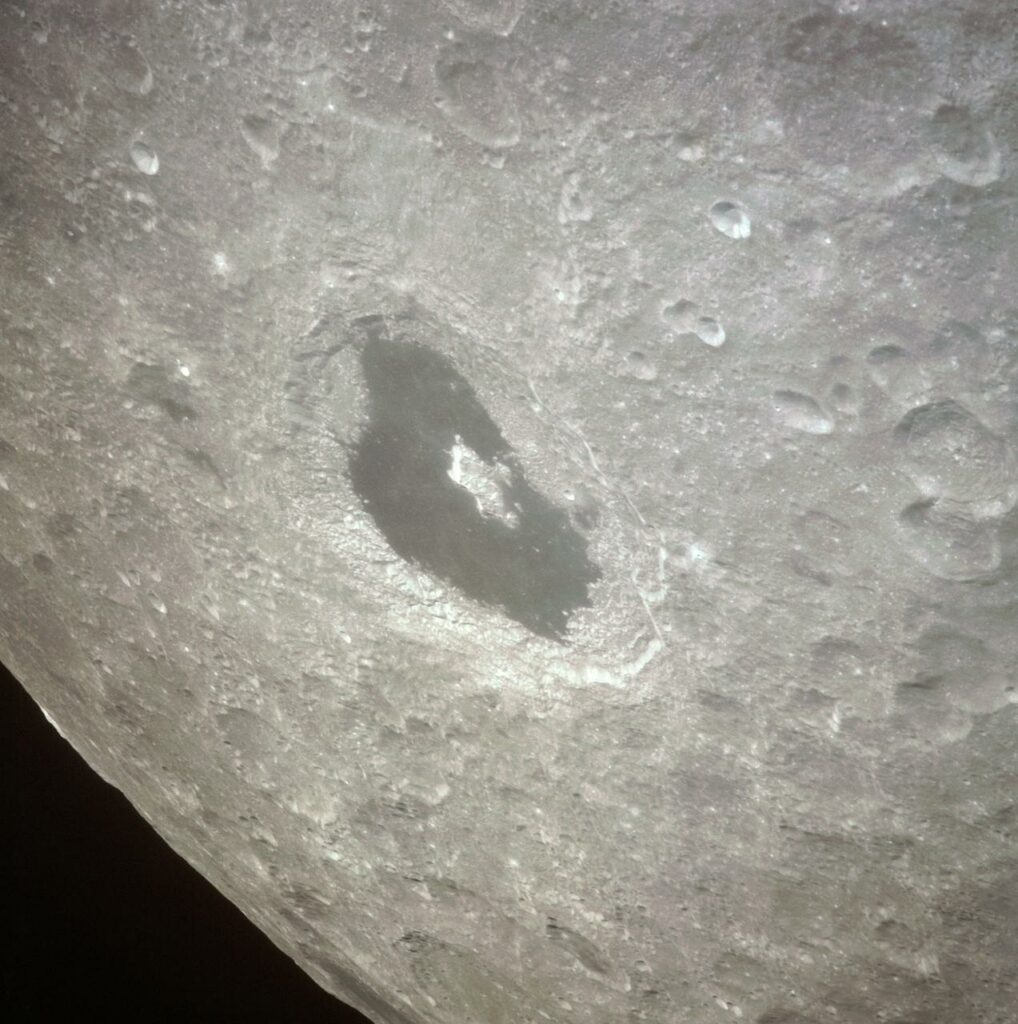
Also building on Apollo 12, the third stage of Apollo 13’s Saturn V rocket was guided towards an impact with the Moon, where seismic instruments placed by Apollo 12’s crew recorded the vibrations through the Moon, helping scientists learn about its composition and structure below the surface. Several other missions continued this practice. The impact of the stage was so powerful that it maxed out the gain on the seismometer despite impacting 117 kilometers away, so for future missions, the gain was reduced.
Another experiment was intended to investigate if a satellite could take useful pictures of clouds from geostationary orbit. All the astronauts did was take eleven pictures of the Earth at precise times. The returned photographs were of “excellent quality”. A satellite called ATS-6 was launched in 1974 to prove the concept, with operational vehicles called Synchronous Meteorological Satellites launching later that year. The series later became known as GOES.
The astronauts did take some time for lunar photography, capturing almost 600 images with a 70-mm Hasselblad camera of both the near and far sides of the moon.
One final experiment was called ‘pilot describing function”, a manual control experiment that was supposed to take place in lunar orbit but was instead done during several other points in the mission. The purpose of this demonstration was to improve a model of how astronauts manually piloted a spacecraft, particularly one where the vehicle flexes around. This flexing was particularly strong on the large Saturn V rocket, impacting how a pilot would respond to it. This couldn’t be completely modeled; engineers needed real data. How a pilot reacts to the flexing while in manual control was useful for improving the simulation for further missions.
Millions of people followed the mission of Apollo 13, providing some much-needed public support for the program which was waning after the first and second landings. In fact, it had the second-highest television viewings after Apollo 11. The Soviets even sent four ships to assist in the rescue efforts. Overall, the mission was a “successful failure” according to commander Jim Lovell.
Despite this great outcome, none of the Apollo 13 astronauts flew in space again. Jim Lovell retired three years later, Jack Swigert got in trouble from a scandal on Apollo 15 and was removed from the flight, and Fred Haise flew the shuttle Enterprise for its Approach and Landing Tests but never flew any of the space-worthy orbiters.
Statistics
And now, for some statistics.
The number of toilets in space is nine: four on the ISS, one on Soyuz MS-21, one on Crew Dragon Endurance, one on Crew Dragon Endeavour, one on Shenzhou 13, and one on Tianhe.
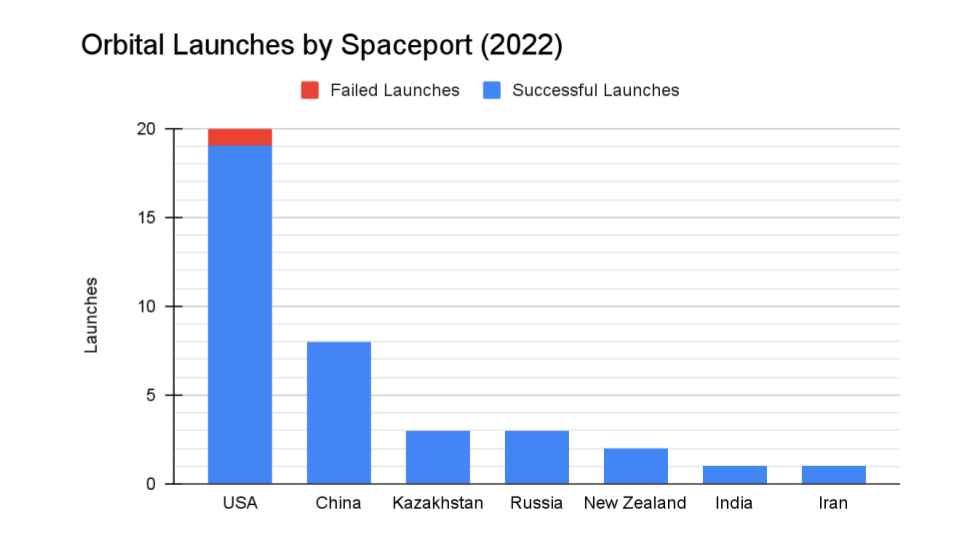
We keep track of orbital launches by launch site, also called spaceport. Here’s that breakdown:
USA 20
China 8
Kazakhstan 3
Russia 3
New Zealand 2
India 1
Iran 1
From those 38 launches, a total of 637 spacecraft were put into orbit.
Your random space fact for this week is that NASA sent up a real human skull, “Detailed Secondary Objective 469″, covered in layers of plastic and thermo-luminescent dosimeters to measure radiation levels at various depths while in space. It flew aboard three space shuttle missions: STS-28, STS-36, and STS-31.
This has been the Daily Space.
You can find more information on all our stories, including images, at DailySpace.org. As always, we’re here thanks to the donations of people like you. If you like our content, please consider joining our Patreon at Patreon.com/CosmoQuestX.
Credits
Written by Pamela Gay, Beth Johnson, Erik Madaus, and Gordon Dewis
Hosted by Pamela Gay, Beth Johnson, and Erik Madaus
Audio and Video Editing by Ally Pelphrey
Content Editing by Beth Johnson
Intro and Outro music by Kevin MacLeod, https://incompetech.com/music/


 We record most shows live, on Twitch. Follow us today to get alerts when we go live.
We record most shows live, on Twitch. Follow us today to get alerts when we go live.